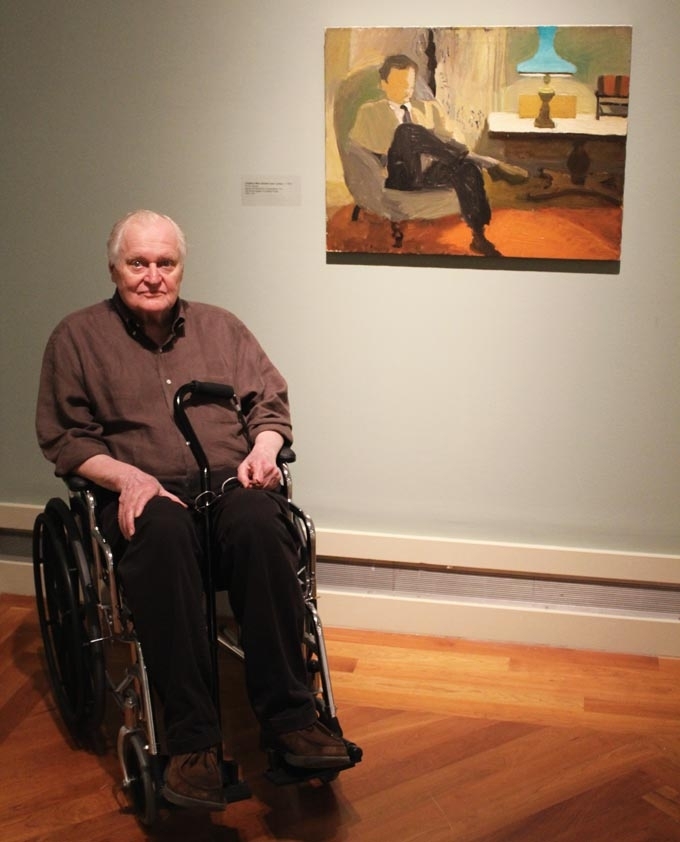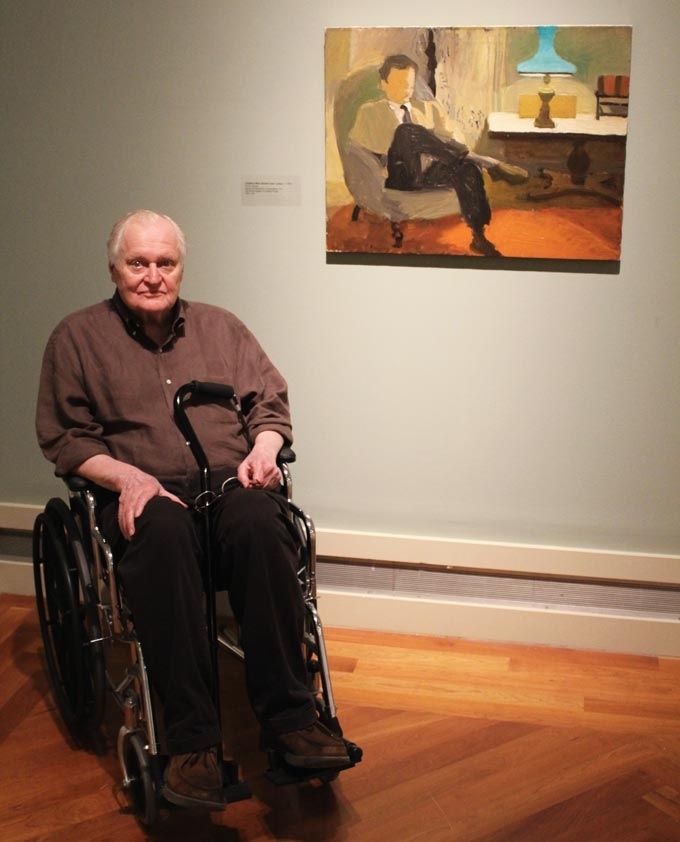Poet John Ashbery Visits His Portrait

Recently, American poet John Ashbery visited the Museum while in Vermont to present a reading at the Bread Loaf School of English. He heard about our current exhibit, Fairfield Porter: Raw—The Creative Process of an American Master, and made a point to explore the exhibit. Ashbery was a friend of Porter, and, in addition to writing a catalogue essay for the 1983 Porter retrospective at the MFA in Boston, he sat for at least one of Porter’s paintings, Untitled (Man Seated near Lamp), which is in Middlebury this summer as part of the exhibit. He graciously agreed to pose next to the painting.

Today is Ashbery’s birthday. To celebrate, we share here with you the opening stanza to his “Self-Portrait in a Convex Mirror.” Those interested can find the full poem here. Enjoy!
Self-Portrait in a Convex Mirror (excerpt)
As Parmigianino did it, the right hand
Bigger than the head, thrust at the viewer
And swerving easily away, as though to protect
What it advertises. A few leaded panes, old beams,
Fur, pleated muslin, a coral ring run together
In a movement supporting the face, which swims
Toward and away like the hand
Except that it is in repose. It is what is
Sequestered. Vasari says, “Francesco one day set himself
To take his own portrait, looking at himself from that purpose
In a convex mirror, such as is used by barbers …
He accordingly caused a ball of wood to be made
By a turner, and having divided it in half and
Brought it to the size of the mirror, he set himself
With great art to copy all that he saw in the glass,”
Chiefly his reflection, of which the portrait
Is the reflection, of which the portrait
Is the reflection once removed.
The glass chose to reflect only what he saw
Which was enough for his purpose: his image
Glazed, embalmed, projected at a 180-degree angle.
The time of day or the density of the light
Adhering to the face keeps it
Lively and intact in a recurring wave
Of arrival. The soul establishes itself.
But how far can it swim out through the eyes
And still return safely to its nest? The surface
Of the mirror being convex, the distance increases
Significantly; that is, enough to make the point
That the soul is a captive, treated humanely, kept
In suspension, unable to advance much farther
Than your look as it intercepts the picture.
Pope Clement and his court were “stupefied”
By it, according to Vasari, and promised a commission
That never materialized. The soul has to stay where it is,
Even though restless, hearing raindrops at the pane,
The sighing of autumn leaves thrashed by the wind,
Longing to be free, outside, but it must stay
Posing in this place. It must move
As little as possible. This is what the portrait says.
But there is in that gaze a combination
Of tenderness, amusement and regret, so powerful
In its restraint that one cannot look for long.
The secret is too plain. The pity of it smarts,
Makes hot tears spurt: that the soul is not a soul,
Has no secret, is small, and it fits
Its hollow perfectly: its room, our moment of attention.
That is the tune but there are no words.
The words are only speculation
(From the Latin speculum, mirror):
They seek and cannot find the meaning of the music.
We see only postures of the dream,
Riders of the motion that swings the face
Into view under evening skies, with no
False disarray as proof of authenticity.
But it is life englobed.
One would like to stick one’s hand
Out of the globe, but its dimension,
What carries it, will not allow it.
No doubt it is this, not the reflex
To hide something, which makes the hand loom large
As it retreats slightly. There is no way
To build it flat like a section of wall:
It must join the segment of a circle,
Roving back to the body of which it seems
So unlikely a part, to fence in and shore up the face
On which the effort of this condition reads
Like a pinpoint of a smile, a spark
Or star one is not sure of having seen
As darkness resumes. A perverse light whose
Imperative of subtlety dooms in advance its
Conceit to light up: unimportant but meant.
Francesco, your hand is big enough
To wreck the sphere, and too big,
One would think, to weave delicate meshes
That only argue its further detention.
(Big, but not coarse, merely on another scale,
Like a dozing whale on the sea bottom
In relation to the tiny, self-important ship
On the surface.) But your eyes proclaim
That everything is surface. The surface is what’s there
And nothing can exist except what’s there.
There are no recesses in the room, only alcoves,
And the window doesn’t matter much, or that
Sliver of window or mirror on the right, even
As a gauge of the weather, which in French is
Le temps, the word for time, and which
Follows a course wherein changes are merely
Features of the whole. The whole is stable within
Instability, a globe like ours, resting
On a pedestal of vacuum, a ping-pong ball
Secure on its jet of water.
And just as there are no words for the surface, that is,
No words to say what it really is, that it is not
Superficial but a visible core, then there is
No way out of the problem of pathos vs. experience.
You will stay on, restive, serene in
Your gesture which is neither embrace nor warning
But which holds something of both in pure
Affirmation that doesn’t affirm anything.
